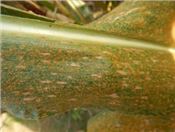Seeing Orange In Your Corn?

Figure 1. Orange pustules of the southern rust pathogen covering a corn leaf.
Photo: Carl Bradley, UK
DR. CARL A. BRADLEY
PRINCETON, KY.
The pathogen of southern rust of corn (Puccinia polysora) has infected a lot of corn fields in Kentucky within the last month. Orange pustules (Figure 1) covering affected leaves are common, and can make your shirt turn orange when walking through a field (which might be good for any Tennessee Volunteer or Illinois Fighting Illini college football fans, but a little disconcerting for corn farmers).
Southern rust is different from another corn rust disease known as common rust (caused by Puccinia sorghi). Southern rust is considered a more tropical disease and needs warm weather to occur, whereas, common rust is more likely to occur in slightly cooler weather (generally in spring and then later on near harvest). Most dent corn hybrids have some resistance to common rust, but nearly all dent corn hybrids are susceptible to southern rust. Neither the southern nor the common rust pathogen can overwinter in Kentucky, but both can blow up during the season from the south.
Since southern rust is prevalent now, I have received several questions in the last few weeks. Those questions, along with my best answers are below:
Will southern rust affect the yield of my corn crop?
This all depends on when infection first occurred relative to the growth stage of the crop. From results of foliar fungicide trials conducted in my past experience at the University of Illinois, southern rust was more likely to cause detectable yield reductions when pustules were first observed sometime between R1 (silking) and R3 (milk) stages. Although detection of southern rust at later stages (R4-dough and beyond) could lead to leaves that were completely covered with pustules, yield reductions were less likely to be detected.
Will southern rust affect stalk quality (lodging)?
Possibly. Any stresses that cause reduced photosynthesis in corn plants can cause the plant to “cannibalize” itself, and move carbohydrates from the roots and stalk to the ear for kernel development. This process can predispose the stalk to infection by stalk rot pathogens.
Is it safe to use southern rust-infested corn for silage or grain for feeding?
A journal article by Querioz et al. (2012) reported that corn infested with high levels of southern rust was more likely to have higher levels of aflatoxin compared to plants with no southern rust or plants with a medium level of southern rust. The southern rust pathogen does not produce any known unsafe mycotoxins, such as aflatoxin. In this case, what likely happened was that plants that were severely affected by southern rust dried down earlier and were at higher risk to infection by Aspergillus species and aflatoxin contamination. Aflatoxin is not likely to be a problem for Kentucky corn growers in 2015, since weather conditions have not really been favorable for infection by Aspergillus species, regardless of southern rust severity. However, it is important to test silage (and grain corn) for mycotoxins before feeding to livestock if there is concern.
Is it safe to breathe in the large amount of southern rust spores that are likely to get into the air during harvest?
As mentioned above, there are no known unsafe mycotoxins produced by the southern rust pathogen. However, breathing in large amounts of southern rust spores could be as dangerous as breathing in large amounts of dust. Wearing a standard dust mask will reduce the risk of breathing in large amounts of rust spores.
What can I do about controlling southern rust next year?
Unfortunately, nearly every dent corn hybrid grown in the U.S. is susceptible to southern rust, so foliar fungicide application is the best way to protect against losses from this disease. In addition, crop rotation will have no effect on southern rust, since it will not overwinter in Kentucky. Keep in mind that southern rust does not appear in Kentucky early enough every year to cause yield reductions, so scouting during the season is important. Most of the common foliar fungicide products marketed for use on corn will provide an acceptable level of control of southern rust. ∆
DR. CARL A. BRADLEY: Extension Plant Pathologist, University of Kentucky